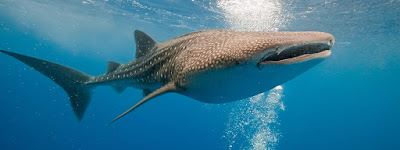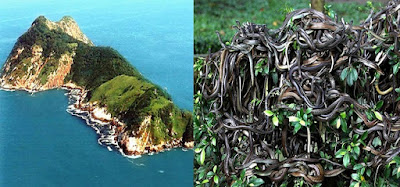Whale Shark ( Rhincodon Typus )
The whale shark (Biological Name : Rhincodon
typus) is a giant of the oceans: the dimensions of its body gives it the
title of the largest fish in the world and therefore, also the biggest shark.
It is the only member of the genus Rhincodon. It
belongs to the order Orectolobiformes and the family Rhincodontidae.
DESCRIPTION
This shark shares the name of the cetaceans because
of its massive size, but it is a fish that can measure up to 20 meters long,
although it has an average size between 9 and 12 meters long. It weighs over
12,500 kilograms. Its fusiform body is wide in the middle area and narrows in
the tail and head that is wide and flat, and it has two small eyes on the
front. Its mouth, located towards the end of the snout, can open about 1.5
meters. Inside there are 300-350 rows of teeth and ten pairs of useful pads to
filter the food.
It has one pair of nostrils at the tip of the snout,
lack of circumnarial grooves but it has rudimentary beards. It has five pairs
of gill slits on each side of the head and spiracles behind the eyes. Like many
pelagic sharks, it has one pair of dorsal fins (one larger than the other) and
one pair of pectoral fins as well as a caudal fin.
The skin of the whale shark has a blue-gray
coloration on the back and white in the belly. The upper area has light spots
that form unique patterns in each shark.
HABITAT
The extensive distribution of this pelagic species
covers all the temperate and tropical seas of the world except the
Mediterranean Sea. They inhabit waters in the latitudes between 30 ° north and
35 ° south in countries like Mexico, Belize, Ecuador, South Africa, Australia
and the Philippines.
This shark inhabits both deep waters and shallow
waters with temperatures between 21 ° and 30 ° C but tolerates water up to 3 °
C degrees in some cases. Their favorite habitats are coastal areas with
abundant food.
Whale shark – Rhincodon typus.
FEEDING
Fortunately for many animal species (including
humans), the natural food of the large whale shark is mainly plankton, although
occasionally includes other small animals such as krill, jellyfishes, sardines,
anchovies, mackerels, squids, and crabs, as long as they are small.
Their feeding method consists of suction and
filtration; Is called “passive feeding” since there is little pumping and
muscular activity in the gills while they eat. While swimming, the shark tends
to keep its mouth open to access the food and suck it hard. Once inside, the
whale shark closes its mouth, and the plankton gets trapped in its filtering
organs, and at the same time, they expel the water through the gills. The
reason for the presence of teeth is unknown because they do not use them for
eating.
It can actively feed when it opens and closes its
jaws to catch the food at any given time, and passively when it keeps its mouth
open as it swims forward and the food gets inwards.
BEHAVIOR
It is one of the most docile sharks that exist and
does not present any danger to humans. They even allow divers to have contact
with them despite the scientists’ disapproval of this activity.
It is an intelligent animal who demonstrates the
ability to learn. Captive sharks in aquariums exhibit changes in their behavior
when humans come to feed them as they begin to swim in circles. Observations
indicate that they sometimes perform a cough-like activity, presumably to clean
their filter pads.
They usually swim unaccompanied by other sharks, but
on certain occasions (feeding and mating) they travel long distances together.
It is also possible that they modify their swimming patterns according to the
environmental conditions.
Whale shark with remoras.
REPRODUCTION
Some scientists think that they have a polygamous
mating system, but this is not confirmed. Except for some research, there is
not much information about whale shark mating and reproduction and birth has
never been observed.
They reproduce through ovoviviparity and females
deliver live pups that reach a length between 40 and 60 centimeters. The number
of offspring is not determined, but apparently, they are many because during
the 90 s a female captured had about 300 fetuses inside. The pups are not born
all at the same time; the female stores the sperm of a male and can develop new
offspring after some time.
Males and females reach sexual maturity around 30
years old.
For more Details :Whale Shark's encyclopedia



Comments
Post a Comment
Your suggestions